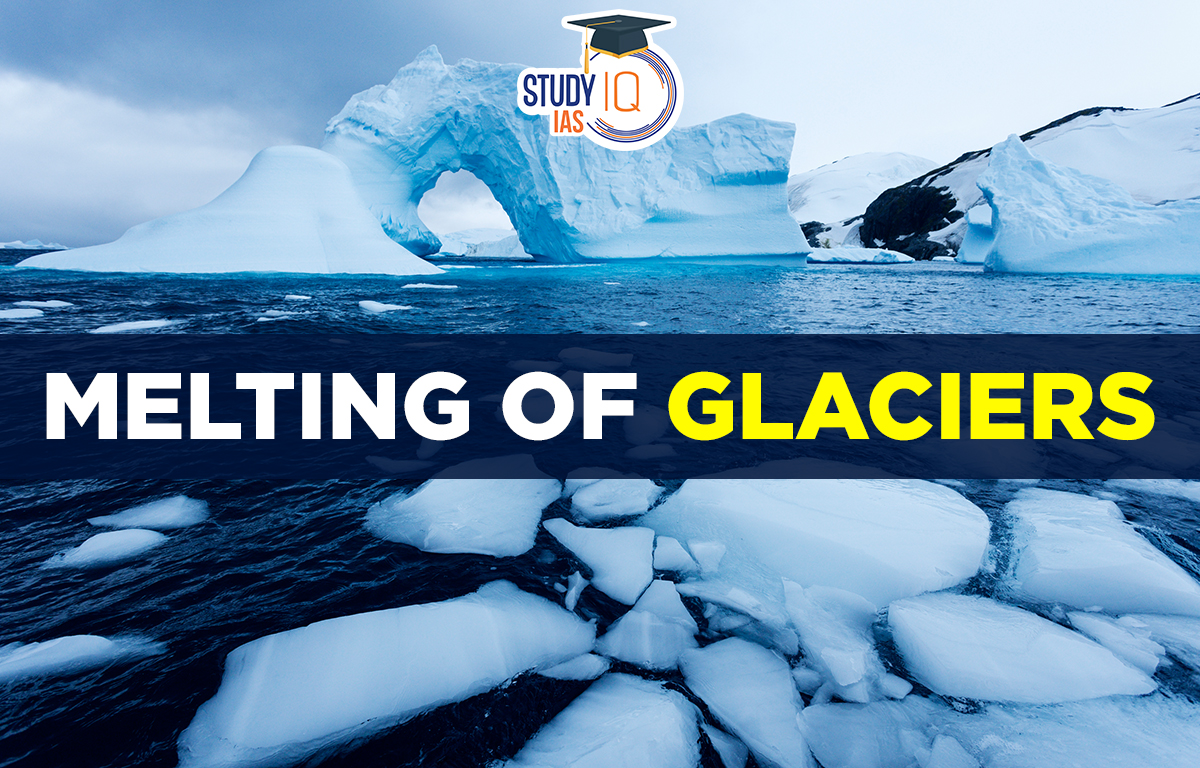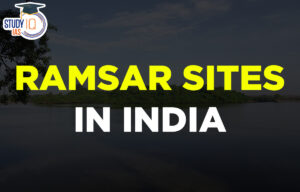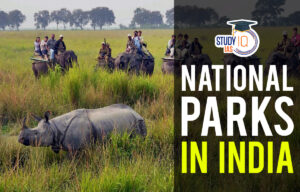Table of Contents
Context: A newly published study has found that glaciers worldwide have been losing 273 billion tonnes of ice per year, leading to a sea level rise of nearly 2 cm in the 21st century alone.
What are Glaciers?
- Glaciers are huge blocks of ice that move slowly, formed from compressed snow over centuries. They are mostly found in Polar Regions, but can also be found in mountain regions closer to the Equator, such as the Andes. Glaciers hold about 2% of the Earth’s water and can take thousands of years to form, with their size changing over time.
- During thaws, glaciers behave like rivers and their speed is determined by friction and the slope of the terrain they travel. Glaciers cover 10% of the Earth’s surface and hold about 70% of the world’s freshwater, including ice caps.
Why the Sea Level is Rising?
Sea level rise is the increase in the ocean’s surface height, measured from the centre of the Earth. The two main causes are:
Melting of Glaciers and Ice Sheets
- Glaciers (large masses of ice and snow moving over land) are melting due to global warming.
- Ice sheets (glaciers covering more than 50,000 sq. km) in Greenland and Antarctica are also losing ice at an alarming rate.
- Since 2000, glaciers have lost 5% of their ice globally, a rate higher than even the Greenland and Antarctic ice sheets.
Thermal Expansion of Seawater
- As global temperatures rise, oceans warm up.
- Warm water expands in volume, contributing to one-third to half of global sea level rise.
- NASA has confirmed that thermal expansion is a major driver of rising sea levels.
Sea level rise is not uniform worldwide
- Southwestern Indian Ocean: Rising at 5 mm per year, higher than the global average.
- Reasons for Uneven Rise: Local changes in ocean heat content and salinity.
Concerns due to Sea Level Rise
Coastal Flooding and Land Loss
- Rising sea levels lead to frequent and intense coastal flooding.
- West Bengal alone lost 99 sq. km of land between 1990 and 2016.
- More flooding results in higher coastal erosion, displacing coastal populations.
Impact on Coastal Ecosystems
- Higher sea levels push seawater inland, damaging ecosystems such as Mangroves, Coral reefs & Salt marshes.
- These ecosystems are vital for biodiversity and protect coastal areas from storms.
Increased Storm Surges and Saltwater Contamination
- Rising sea levels intensify storm surges during tropical cyclones, causing more destruction inland.
- Saltwater intrusion contaminates freshwater supplies, affecting: Drinking water, Agriculture & Fisheries.
Human Population at Risk
- A 2024 study in Scientific Reports found that:
- 29% of the global population lived within 50 km of the coast in 2018.
- 15% lived within just 10 km of water bodies.
UN’s World Meteorological Organization’s Report Sounds Alarm
- Glaciers around the world melted rapidly last year, and it may be impossible to save them. Greenhouse gas concentrations, including CO², have reached new heights, resulting in record-breaking ocean temperatures and a major decline in Antarctic sea ice.
- Sea levels have increased at an average rate of 4.62 millimetres per year since 2013, twice as fast as the previous decade. Oceans absorb around 90% of the heat that greenhouse gases trap on Earth.
- The 2015 Paris Agreement aimed to limit global warming to “well below” 2 degrees Celsius above pre-industrial levels, with a preference for 1.5 degrees Celsius.
What are the causes of Glacial Melting (Deglaciation)?
- Global warming: Melting glaciers can be attributed to global warming caused by human activities, primarily the release of greenhouse gases such as carbon dioxide and methane from industry, transportation, and fossil fuel use.
- Deforestation: It contributes to global warming by releasing more carbon dioxide into the atmosphere while reducing the amount absorbed by trees.
- Additionally, rapid industrialization has led to glacier melting since the early 1900s.
- Climate change: It contributes to other factors that can increase glacier melt, such as changes in precipitation patterns and a decrease in snowfall.
- Natural Factors: Natural factors such as volcanic eruptions, El Niño events, and oceanic and atmospheric circulation patterns can also affect glacial melting.
- Albedo Effect: The albedo effect measures the reflectivity of a surface, and glaciers play a significant role in reflecting sunlight back into space. However, reducing ice cover leads to a lower albedo effect, which, in turn, leads to more sunlight absorption and warming of the atmosphere.
Effects of Melting Glaciers (Deglaciation)
- Sea level rise: Glacial melting has contributed to raising sea levels by 2.7 centimetres since 1961. Sea ice melts. This, in turn, increases coastal erosion and storm surge. The main causes of the rise in sea levels are the Antarctic and Greenland ice sheets.
- Weather Patterns: The melting of ice eliminates the cooling effect that previously existed, causing darker patches of the ocean to emerge. This leads to warmer air temperatures and disrupts normal patterns of ocean circulation. Research shows that the polar vortex is appearing more frequently outside of the Arctic due to changes in the jet stream, caused by warming air and ocean temperatures in the Arctic and the tropics.
- Fishing Industries: The warmer waters resulting from melting glaciers change where and when fish spawn, affecting industries that rely on vibrant fisheries. Coastal communities will continue to face billion-dollar disaster recovery bills as flooding becomes more frequent and storms become more intense.
- Wildlife: Melting glaciers in the Arctic cause wildlife such as walruses to lose their home, and polar bears to spend more time on land, increasing conflict between people and bears.
- Fresh Water Scarcity: Melting glaciers result in less accessible fresh water for human usage, whether it is for drinking, hydroelectricity production, or agriculture.
- Threat to Coral Reefs: Melting glaciers and rising sea levels prevent coral reefs from receiving adequate sunlight, which is necessary for their survival. This threatens their ability to thrive through the process of photosynthesis.
- Influence on ocean currents: In addition, rapid glacial melt in Antarctica and Greenland influences ocean currents and slows them down, as massive amounts of very cold glacial melt water enter warmer ocean waters. As ice on land continues to melt, sea levels will keep rising, presenting a significant threat to our planet.
- Glacier hazards: They also increase in risk related to glacier hazards due to the enhanced number and volume of glacier lakes, accelerated flash floods and Glacial Lake Outburst Floods (GLOFs), impact on agro practices in the high Himalayan region etc.
Pattern of losses of ice bodies in different parts of the world
Antarctica
- Antarctica is one of the fastest-warming regions on the planet, with a temperature increase of over 3°C in the past 50 years.
- Annual ice loss in Antarctica has increased at least sixfold between 1979 and 2017.
- 87% of glaciers along the West Coast of the Antarctic Peninsula have retreated in the last 50 years, with accelerated retreats in the past 12 years.
Greenland
- Glaciers in Greenland and Antarctica are losing ice at alarming rates due to warm ocean water seeping beneath and melting them from the bottom up.
- The breaking of the Larsen C ice shelf in Antarctica and several smaller ice shelves in the Arctic are a result of global warming.
Russian Arctic
- Ice mass loss in the Russian Arctic has nearly doubled over the last decade.
- Glaciers in the Russian Arctic are shrinking by area and height, with an increase in the recent speed of ice loss.
South America
- The Chacaltaya glacier in the Bolivian Andes, which was 18,000 years old, has disappeared.
- Avalanches have occurred at the base of the Cayambe glacier in Ecuador and caused serious damage in the area of Pampa Linda, confirming the trend towards the collapse of the Andean glaciers.
Way Forward
Mitigation and adaptation strategies are two approaches to addressing the issue of glacial melting or deglaciation. Here are some ways to adopt each strategy:
Mitigation Strategies
Mitigation strategies aim to address the root causes of glacial melting by reducing greenhouse gas emissions and limiting global warming. Here are some examples of mitigation strategies:
- Transition to Renewable Energy: Encouraging the use of renewable energy sources like wind, solar, and geothermal energy to reduce reliance on fossil fuels.
- Energy Efficiency: Improving energy efficiency in buildings, transportation, and industry can help to reduce greenhouse gas emissions.
- Forest Protection and Reforestation: Protecting forests from deforestation and promoting reforestation efforts can help to absorb carbon dioxide from the atmosphere.
- Carbon Capture and Storage: Developing technology to capture and store carbon dioxide emissions from power plants, factories, and other sources.
- International Climate Agreements: International agreements like the Paris Agreement aim to limit global warming by setting targets for reducing greenhouse gas emissions.
Adaptation Strategies
Adaptation strategies aim to address the impacts of glacial melting that are already happening or are likely to happen in the future. Here are some examples of adaptation strategies:
- Early Warning Systems: Developing early warning systems to alert communities to glacial meltwater floods, landslides, and other hazards.
- Infrastructure Planning: Planning infrastructure to withstand the impacts of glacial meltwater floods, sea-level rise, and other climate-related hazards.
- Ecosystem Protection and Restoration: Protecting and restoring ecosystems that provide services like flood control and water supply.
- Community Education and Training: Educating and training communities to prepare for and respond to the impacts of glacial melting.
- Disaster Risk Reduction: Developing disaster risk reduction strategies and plans that take into account the impacts of glacial melting and other climate-related hazards.


 Ramsar Sites in India 2025 List: Names, ...
Ramsar Sites in India 2025 List: Names, ...
 List of National Parks in India 2025, Ch...
List of National Parks in India 2025, Ch...
 Bonnet Macaques: Habitat, Features, Beha...
Bonnet Macaques: Habitat, Features, Beha...

























